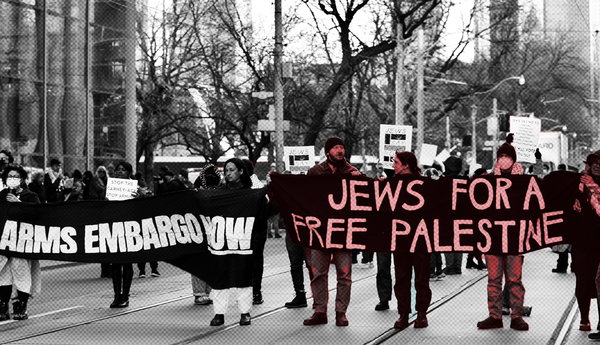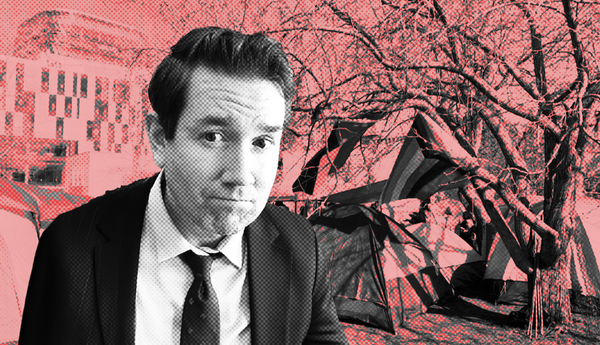In the first weeks of Russia’s invasion of Ukraine, Canada’s directorate of NATO policy said that Ukraine’s notorious Azov Regiment continued to be far-right “fanatics” despite their integration into the country’s national guard, emails obtained by The Maple through an access to information request show.
Recruits belonging to the same military unit were photographed last year holding what a leading arms monitoring researcher said were Canadian-made assault rifles fitted with Canadian-made scopes. It is unclear which foreign military supplied the weapons to Ukraine, however.
The NATO policy directorate’s assessment contradicts claims frequently made by Azov’s defenders, who insist that the controversial military unit was de-radicalized after it was formally integrated into the Ukrainian forces — a claim often repeated by Western media sources.
The claims about Azov’s de-radicalization have also been a key part of narratives that portray those who raise concerns about the unit as carrying water for Russia’s invasion.
Besides apparent material aid, Azov also continues to enjoy words of support from some prominent Western media outlets amid Ukraine’s lagging war effort.
Voice of America (VOA), a U.S. state broadcaster that is regarded by critics as a pro-Washington mouthpiece, ran approving coverage of a protest held in front of the White House last November in support of Azov soldiers imprisoned by Russia.
The VOA article did not acknowledge the group’s far-right ideology, which some commentators and news outlets claim no longer exists. That view contrasts sharply with assessments shared among Canadian military officials back in 2022.
‘They Are Fanatics’
In March 2022, the Department of National Defence (DND) was facing media questions over mounting allegations that the Canadian Armed Forces (CAF) had trained far-right groups in Ukraine, including Azov, prior to Russia’s invasion.
In an internal email sent to Lt. Col. Andre Salloum, DND’s then-director of communications, Elana Aptowitzer, quoted “information from the Directorate of NATO Policy.”
Copied text in the email read:
“It’s true that Azov was brought into the NGU [National Guard of Ukraine], but we don't train them because they are fanatics, and we don't share their values … It’s true that the Azov has dogged us as an issue for years, but we should definitely not hide from the fact that we train the NGU because of a small minority in their ranks.”
DND confirmed in an email to The Maple that the ministry still regards Azov Regiment as a far-right extremist group.
“Our position remains that we are not – nor will we – be providing support to Azov and affiliated entities,” the ministry said in an unsigned email. “We continue to vehemently oppose any and all racist, discriminatory and hateful views and any groups that promote them.”
The Maple first filed the ATIP request in August 2022, but DND did not release the documents until a year later, and only after The Maple filed a formal complaint with the federal Information Commissioner. The Commissioner found The Maple’s complaint to be “well founded,” and said DND’s delays “undermine[d] the credibility of the access system,” echoing similar comments made in its investigation into an earlier complaint made by The Maple against DND.
Repeated Denials
DND’s repeated denials that it trained or provided support to Azov come against evidence to the contrary that has emerged over the past several years.
In 2021, the Ottawa Citizen’s David Pugliese found that Canadian officers who were reported to have met with and been briefed by Azov members in 2018 did not denounce the group, but instead feared that journalists would expose the meeting.
In April 2022, Radio Canada and CTV News reported on further evidence showing that the CAF had trained members of Ukraine’s military who were reported to be members of far-right groups, including Azov, as recently as 2020.
In September 2022, DND would not rule out the possibility that Canadian weapon transfers to Ukraine had ended up in Azov Regiment’s hands when asked directly by The Maple.
Photographic evidence highlighted by Project Ploughshares researcher Kelsey Gallagher last February appeared to show Azov recruits training with Colt Canada C7 rifles fitted with ELCAN Specter optics. However, it is not clear who supplied those weapons.
The DND website stated that the ministry transferred 700 carbine rifles from the CAF’s inventory to Ukraine in February 2022, but did not list assault weapons, like the C7, in that package.
DND said it sent a $59 million package of small arms and ammunition sourced from Colt Canada in April 2023, followed by another $60 million package last November. These packages included assault weapons using 5.56 millimetre cartridges, matching the caliber of C7s.
According to The Armourer’s Bench, a blog run by two British arms historians, DND said in November 2022 that it had not transferred C7 rifles to Ukraine at that time. The weapons used by Azov recruits pictured in February last year may have been transferred to Ukraine by other NATO militaries that also use the C7.
The ‘Azov Debate’
Azov Regiment has been a point of heated debate since Russia launched its invasion of Ukraine in February 2022. Critics of the unit point to its ongoing use of Nazi symbols, and evidence of continuing links to Andrey Biletsky, a white supremacist, Azov founder and leader of the far-right National Corps political party. Until Russia launched its invasion, extensive reporting from Western media outlets documented comments from Azov commanders and members who openly endorsed neo-Nazi ideas.
Those who defend Azov, including some Western news outlets and opinion writers, claim that since it was integrated into Ukraine’s national guard in 2014, the regiment has been gradually deradicalized and today functions as an ordinary military unit. Focusing on the group’s neo-Nazi origins, they argue, lends credence to Russia’s claim that its invasion of Ukraine was necessary because the country was overrun with fascists and needed to be “de-Nazified.”
Last year, The Maple found that major Canadian news outlets adopted this position during the spring of 2022, when Azov fighters were engaged in an intensive battle against Russian forces in Azovstal. At this time, news stories began suggesting that the group’s Nazi ideology was consigned to its past, or the publications glossed over the issue entirely.
This culminated in a profile published by The Globe and Mail in August 2022 that critics said whitewashed Azov’s ongoing neo-Nazism and functioned as a piece of far-right propaganda, regardless of the reporter’s intent. The Globe reporter wrote that Azov “has a history of far-right leanings but is now part of the Ukrainian army.”
Writing in The Nation last June, The Forward correspondent Lev Golinkin accused Western media of whitewashing the neo-Nazi unit.
“This overnight normalization of white supremacy was possible because Western institutions, driven by a zeal to ignore anything negative about our Ukrainian allies, decided that a neo-Nazi military formation in a war-torn nation had suddenly and miraculously stopped being neo-Nazi,” he wrote.
“But the truth is that this is an easily debunked fantasy spun out by a handful of propagandists.”
Speaking to The Maple in 2022, Ottawa University Professor Ivan Katchanovski told The Maple that the changing news coverage of Azov Regiment reflected a political calculation driven by a desire to promote Ukraine’s war effort, irrespective of inconvenient facts about some of the country’s far-right soldiers.
“This is also going to have a dangerous effect on Ukraine and potentially other countries because now, basically, Nazis in Ukraine are made into national heroes,” said Katchanovski.
Social media giant Meta also embraced claims about Azov’s de-radicalization, as it removed the military unit from its list of dangerous individuals and organizations last year. Last June, Stanford University hosted an Azov delegation, during which Azov’s neo-Nazi Wolfsangel insignia was projected onto the wall, according to The Forward.
Alex Cosh is the news editor of The Maple.
ATIP documents:







